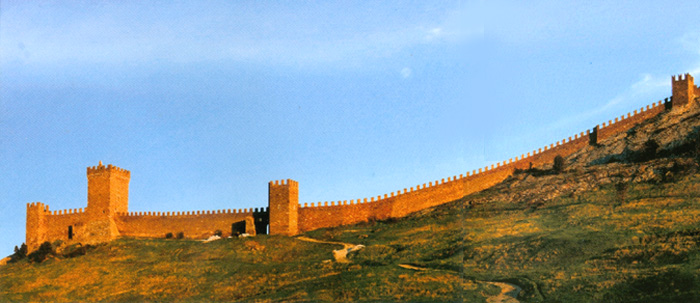
14th Century Genoese fortress and factory, including a fonduk (warehouse), at Soldaia (now Sudak), Crimea;
the primary "product" was slaves

The seminal importance of continuity in historiography has been noted by historians other than Lucy Dawidowicz. Continuity has been explicitly and repeatedly appealed to by Charles Verlinden, including several waves of medieval colonization of Europe (the Mediterranean including the Levant, North Africa, and the New World).
The Crusades were a pre-modern form of colonization by Europeans in Palestine and the Levant (Byzantium, Syria and Cyprus). The Genoese and Venetians were engaged in trans-Mediterranean trade, including North Africa (Ceuta, Bougia, Gades, Tunis, Alexandria, etc.), the countries of the northwest Mediterranean (southern France, Barcelona, Baleric Islands, etc.), the Italian peninsula (Sardinia, Corsica, Sicily, etc.), and Ionian islands such as Chios. The Genoese also maintained colonies in the Black Sea (Caffe, Cembalo, Soldaia, Arushta, etc.), and Venice maintained a colony at Tana at the delta of the Don River on the Sea of Azov.
Initially Byzantium was very powerful, so when the Europeans attempted to colonize the Levant they focused on Syria, Cypress, Crete and Palestine. Eventually Constantinople fell, and Byzantium became weak enough to enable the Genoese and Venetians to establish a virtual protectorate (1204-1261). 1 With access to the Black Sea thus enabled, it was possible for the Genoese and Venetians to establish colonies on the Crimean peninsula and at Tana. This in turn provided access to valuable luxury goods from the Silk Road trade route, and access to slaves from the colonized Slavic areas. The Genoese, in particular, employed slaves from their Slavic colonies in sugar plantations at Palestine and Syria, and in the alum mines of Phocaea, and later in Kolonia. 2,3
In 1453 Constantinople fell a second time, to the powerful Ottoman Turks. The Ottomans also seized control of much of Palestine. As Black Sea shipping was now sealed off at the Bosphorus at the Dardanelles, Genoese and Venetian investments in trade colonies on the Black Sea, Palestine and Syria (including sugar, slaves and alum) had to be shifted somewhere else. The Genoese and Venetians shifted the use of slaves and sugar plantations to Crete, Cyprus, Chios, Sardinia, and Sicily.4
While the Genoese and Venetian colonies were being established in the Levant, the Portuguese were exploring the Atlantic ocean, seeking navigational routes around Africa. Spain and Portugal discovered the Atlantic archipelagos: the Canaries, the Madeiras, and the Azores. Sugar plantations were then established in these Atlantic archipelagoes5 using slave labor — except that the slaves came not from the Crimea and the Levant, but from Africa.
With the discovery of the New World, the Genoese heading the Spanish Casa de Contratación and the Portuguese Casa dos Escravos created the first sugar plantations in Española and Brazil. 6
Historian Charles Verlinden points out that there is a direct continuity of the employment of slaves at sugar plantations and in mines providing the economic basis of colonization in two places and at two times: both the end of the 11th century during the period of the Crusades (in the Levant, including the Black Sea), and by the end of the 15th century, in the Atlantic archipelagoes of the New World. These waves of continuity continued in the New World. This was followed by German attempts at colonization in what is now called Eastern Europe, circa the 18th century (see Jan M. Piskorski), colonization carried out by various European countries in Africa and South America during the 18th and 19th centuries, and finally the German colonization in Wartheland during the 20th century. Thus there is continuity of colonization by Europeans for almost one thousand years. The moral justification for this long period of colonization is given by Charles Verlinden in terms of time, place, industrial technique and culture — although it is not clear that the West is culturally superior to the peoples it conquered. Historians, cultural anthropologists, and geneticists differ on this.
Eugenics is just another attempt to justify continuity forced by the invader on the conquered. Modern anthropology shows that there is no such basis of moral superiority; no cultural continuity.
Eugene Byrne, "Commercial Contracts of the Genoese in the Syrian Trade of the Twelfth Century", Quarterly Journal of Economics, Vol. I, 1916, pp. 129-170.
Eugene Byrne, "Genoese Shipping in the Twelfth and Thirteenth Centuries", Cambridge, Mass., 1930.
Italian-Ukrainian initiative for Genoese fortifications on the
Mediterranean and Black Sea UNESCO World Heritage List, Banca Carige
"The Genoese in Crimea: A historical guide", Vyd-vo Gorobec publisher, Kiev, 2009, ISBN: 9789669694096
H. B. Johnson, Jr., "From Reconquest to Empire: The Iberian Background to Latin American History", Alfred Knoph, New York, 1970
Robert S. Lopez and Irving W. Raymond, "Medieval Trade in the Mediterranean World: Illustrative Documents", Columbia Univ. Press, 1968
Hilmar C. Krueger, "The Routine of Commerce between Genoa and North-West Africa during the late Twelfth Century", The Mariner's Mirror, Vol. 19, 1933, Cambridge Univ. Press, pp. 417-438
Hilmar C. Krueger, "The Wares of Exchange in the Genoese-African Traffic of the Twelfth Century", Speculum: A Journal of Mediaeval Studies, Vol. 12, No. 1, January, 1937, The Mediaeval Academy of America, Cambridge, Mass., pp. 57-71
Eizo Matsuki, "The Crimean Tatars and their Russian-Captive Slaves: an Aspect of Muscovite-Crimean Relations in the 16th and 17th Centuries", Mediterranean Studies Group at Hitotsubashi University
Jan M. Piskorski (Ed.), "Historiographical approaches to Medieval Colonization of East Central Europe: A comparative Analysis against the Background of other European Inter-ethnic Colonization Processes in the Middle Ages", Columbia Univ. Press, New york, 2002
John H. Pryor, "Mediterranean commerce in the Middle Ages: a voyage under contract of commenda", Viator, Vol. 14, 1983, pp. 133-194
Charles Verlinden, "The Rise of Spanish Trade in the Middle Ages", The Economic History Review, Vol. X, 1939-40, pp. 44-59.
Charles Verlinden, "Italian Influence in Iberian Colonization", The Hispanic American Historical Review, Vol. XXXIII, No. 2, May, 1953, pp. 199-211.
Charles Verlinden, "The Beginnings of Modern Colonization: Eleven Essays with an Introduction", Cornell Univ. Press, 1970.